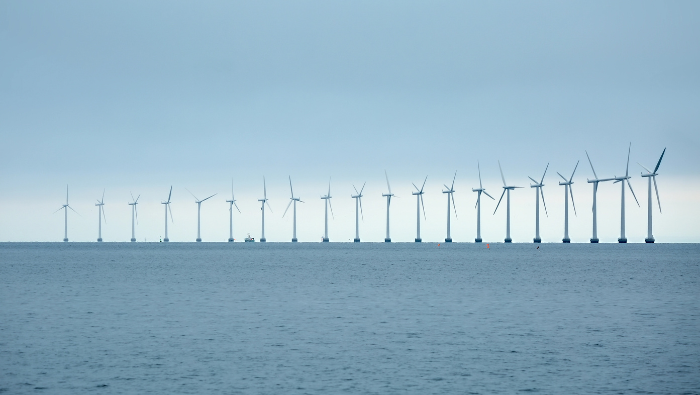Costs up, carbon price expectations down since AR4
No new offshore wind projects bid in Allocation Round 5 (AR5) of the UK Government CfD scheme, potentially jeopardising UK wind power targets.
The auction awarded 15-year contracts to winning renewable energy projects, but developers have said the maximum bid price set for offshore wind, at ~£44 /MWh (real 2012), was too low. Many say this is due to higher material costs but, in our view, this is not the main reason.
Business cases for UK offshore wind projects appear predicated on receiving higher revenues in the future – after the 15-year CfD period expires – when power prices are expected to be higher, due to high carbon prices. But three things have changed since AR4 in 2022 to undermine this position.
Firstly, contrary to the common argument for the failure of AR5, the cost of materials (e.g. steel, copper etc.) have in fact fallen in the last year – currently adding only ~£1.5 /MWh to overall costs. General supply chain inflation, over and above material costs, will have lifted build costs (n.b. anything up to 40% has been suggested), as have higher financing costs – and these increases do imply higher required revenues are needed to maintain returns.

Secondly, Crown Estate, which leases seabed rights, has changed its leasing mechanism, which adds up to ~£40 /MWh to the Levelised Cost of Electricity (LCoE) of offshore wind. The main beneficiaries of this increase are the UK Treasury and Royal Household.
Thirdly – and most importantly in our view with respect to AR5 – expectations for higher carbon prices in the UK have diminished following government actions to increase availability of emission allowances under the UK Emissions Trading Scheme. This saw the UK carbon price fall by 60% relative to the EU price, or ~£50 /tCO2.

Additional policy moves by the UK Government, to roll-back targets under the UK net-zero plan, raise concerns over future commitments to tackling climate change and have further undermined future carbon price expectations.
This lowering of expectations poses challenges for offshore wind projects that need a higher carbon price and, therefore, higher power prices in the future to be viable. We believe this is the main reason for a lack of bids in AR5.
The cost of offshore wind is not £37 /MWh
Many commentators conflate winning bid prices in previous allocation rounds with the cost of offshore wind, but this is wrong. Rather, they reflect the minimum price developers are willing to receive for power for an initial 15-year period to gain access to the grid – a situation that has arisen due to a lack of grid investment needed for higher levels of renewables.
To put bid prices into context, the £37 /MWh winning bid prices in AR4 are real 2012 prices, equating to ~£50 /MWh (real 2023). This compares with the underlying LCoE of offshore wind at the time of AR4 of ~£82 /MWh (real 2023), including a transmission charge to shore. Assuming a 30-year project lifetime, power prices would need to lift to ~£160 /MWh (real 2023) from year 16, for a project to be viable.
The UK Government forecasts the cost of fossil-based power in 2040 at ~£180 /MWh (real 2021) so there is some alignment, but this forecast is based on carbon at ~£323 /tCO2. For information, CRU’s forecast for the EU carbon price in 2040 is ~£165 /tCO2 (real 2023), reflecting current EU policy, closer to the UK Government 2025 figure (see below).
In our view, recent government policy surrounding climate have shifted the risk/reward balance, and weakened the case for offshore wind under the CfD process as currently structured.

To put the above into context of AR5, a 15% increase in build costs due to supply chain inflation and a 1 percentage point increase in financing costs lift the LCoE of offshore wind from ~£82 /MWh to ~£96 /MWh, or ~17%. In this case, to ensure sufficient returns over the 30-year project lifetime, at a maximum bid price of ~£44 /MWh (real 2012), there needs to be confidence that power prices will lift to ~£200 /MWh (real 2023) by year 16, when the CfD contract expires. Assuming power prices are set by natural gas units, this implies a carbon price ~£370 /tCO2 (real 2023).
The combination of reduced confidence in future carbon prices and, therefore, future power prices, along with increased supply chain and financing costs, is making previously approved projects less viable. This reasoning may be behind Vattenfall’s decision to halt work on the Norfolk Boreas windfarm (a winning bidder in AR4) earlier this summer.
New Crown Estate leasing mechanism adds ~£40 /MWh to offshore wind costs
As indicated, the cost of offshore wind in the UK, prior to current supply chain inflation, was ~£82 /MWh. However, the new Crown Estate seabed leasing mechanism adds significant up-front costs, with the highest bids requiring an annual payment of £154,000 /MW during project development, perhaps up to 10 years. Once built, wind farms revert to normal lease payments of 2% of revenue.
Assuming seven years to reach construction stage, this would imply eight annual payments, including the original bid deposit, which lifts the LCoE of an offshore wind project from ~£82 /MWh to ~£120 /MWh (real 2023), directly adding up to ~£40 /MWh to the LCoE of offshore wind.
Fossil fuel companies were prepared to bid very high prices in the latest lease round and, while these bids will lift the costs of their respective offshore wind projects, they may provide a useful hedge. That is, if carbon prices rise, the projects will make good returns; if carbon prices remain low, the fossil fuel components of their portfolio will gain. Thus, hedging of this sort may drive up the cost of renewable energy more generally, which will increase costs to the public if translated into higher bid prices that are ultimately paid for via grid charges and may make the transition more challenging.
Low carbon price expectations – the main reason for no offshore bids in AR5
Recent policy moves by the UK Government have pulled down the near-term carbon price and negatively impacted expectations that the government is committed to higher carbon prices in the long term. But they are critical to higher future power prices needed for the viability of offshore wind projects. At the same time, current supply chain inflation has lifted costs from ~£82 /MWh to ~£96 /MWh, perhaps higher. Both of these factors directly impact the price offshore wind developers are prepared to bid in the CfD process.
Further out, changes to the Crown Estate seabed leasing mechanism lift future offshore wind costs by up to ~£40 /MWh, which will lift the minimum viable bid price even further in future auction rounds.
Considering the above, the chart below shows maximum viable bid prices under different cost and carbon price assumptions. The bid price of £37 /MWh (real 2012) in AR4 was viable given expectations at the time (green line), but cost inflation and lower carbon price expectations have lifted the minimum required bid price to ~£65 /MWh on the same basis (light blue line). Higher assumed supply chain inflation will lift this bid price further, perhaps to just over £70 /MWh.
Considering higher seabed lease costs (dark blue line), in addition to current supply chain inflation, minimum bid prices would probably need to rise to >£100 /MWh (real 2012). Assuming supply chain inflation abates, but Crown Estate leasing costs remain, the maximum bid price falls to ~£85 /MWh (real 2012) (n.b. relevant line not shown).

If the UK government is to incentivise offshore wind projects, maximum bid prices need to rise to at least ~£65 /MWh (real 2012) to attract bidders, supported by reaffirmed commitments to climate targets.
If you are interested in renewable energy costs and need an independent, transparent and clear understanding of the assumptions behind those costs for your decision making, contact us, we’ll be very happy to talk.
Explore this topic with CRU






